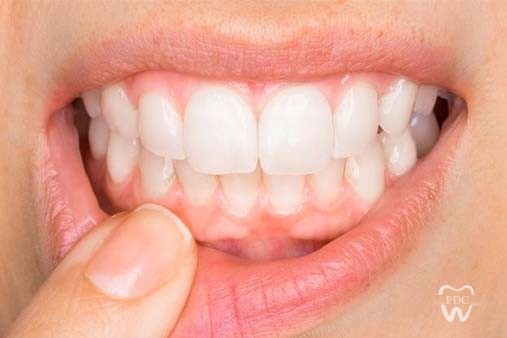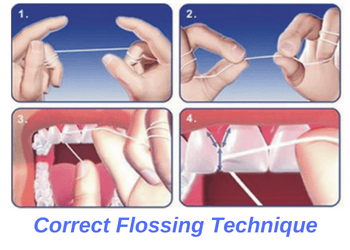The gums and the bone present underneath your gums, in your oral cavity is very important, as these two structures support your teeth and provide it the strength to withstand the chewing forces occuring in your oral cavity. Often, we come accross patients who compain of bleeding and swollen gums and unsure of what is happening to their teeth and gums. Many tend to neglect their gum health as there are no obvious symptoms when it is initially diseased.
That is the reason why we are posting this blog, to let you all know how important it is to take care of your gums in order to have a healhy and beautiful smile.
How are gums important?
When it comes to your oral health, it is not all about how straight your teeth are or how bright your smile is. You should not forget about your gums! Even if you are cavity-free and have the pearliest chompers in town, that does not mean you’re immune to gum disease. Since, it is usually painless, most people have no idea that anything is wrong with their gums. Only when there are symptoms like bleeding and swollen gums, do patients come to seek treatment and at this stage, more invasive treatment is required.
What is gum disease?
Gum disease starts when plaque or food debris builds up under and along the gum line. Plaque is a sticky film-like substance that’s filled with bacteria. It can cause infections that hurt the gum and bone, leading to gum disease and tooth decay. Plaque also can cause gingivitis, the earliest stage of gum disease wherein the gum is inflamed. Gingivitis causes your gums to become:
⦁ Tender
⦁ Red
⦁ Swollen
⦁ Prone to bleeding

Fortunately, since the bone and tissue holding the teeth in place aren’t impacted, this damage is reversible.
However, if you neglect treating your gums at this stage, you can also develop periodontitis, which is an advanced form of gum disease. Periodontitis impacts the bone that holds your teeth in place, giving it support. If left untreated, it can ruin the gums, bone, and tissues connected to your teeth, ultimately causing you to lose your healthy teeth in the future, if no proper treatment is carried out.
The signs that you might have gum disease and what you need to look out for, include:
⦁ Consistently bad taste or breath
⦁ Separating or loose permanent teeth
⦁ Gums that easily bleed
⦁ Gums that are swollen, red, or tender
⦁ Gums that have pulled away from your teeth
The effects of periodontal disease range from mild redness and swelling of the gums (gingivitis) to complete destruction of the tooth’s bony support structure (advanced periodontitis), which is responsible for tooth loss.
Over the years, people with periodontal disease have been found to be at higher risk for cardiovascular disease, diabetes, chronic respiratory disease, pregnancy complications, and dementia. We don’t yet know if periodontal disease actually causes other health problems, or if people with chronic health issues have more difficulty taking care of their teeth and gums. “It’s an association, not a cause-and-effect relationship, says Dr. Van Dyke. “But inflammation, which plays a role in all these conditions, seems to be the link.”
Moreover, the association probably works both ways. For example, diabetes research has determined that successfully treating periodontitis reduces the severity of diabetes and vice versa.
The good news is that gum disease is preventable. Here, are a few ways you can help keep your gums healthy-
- Flossing
Floss at least once a day. This helps remove the plaque and food that is beyond your toothbrush’s reach. It does not matter when you floss. Do it at night, do it in the morning, or do it after lunch… but make sure you floss your teeth!
Water picks, which use a spray of water to dislodge debris between your teeth, can be helpful for people with bridges or braces, but it should not replace regular flossing. - Get regular dental cleanings
Your dentist can detect early gum disease symptoms if you see them on a regular basis. That way symptoms can be treated before they become more serious. A professional cleaning is the only way to remove tartar otherwise known as calculus. It can also get rid of any plaque you missed when brushing or flossing. If you have gingivitis, brushing, flossing, and regular dental cleanings can help reverse it at an early stage.
In certain situations, when the gums are highly infected, your dentist may suggest to go in for ‘laser disinfection’ which is a treatment procedure in which laser is used to disinfect the gums and get rid of the bacteria causing the gum disease. This treatment procedure has proven to be highly effective in curing diseased gums and may require an additional appointment with your dentist. To know more about this procedure, do ask your dentist for further clarifications. - Quit smoking
Yet another reason for smokers to quit: Smoking is strongly associated with the onset of gum disease. Since, smoking weakens your immune system, it also makes it harder to fight off a gum infection, say the Centers for Disease Control and Prevention (CDC). Plus, smoking makes it more difficult for your gums to heal once they have been damaged. - Brush twice a day
Brush your teeth twice a day, and make sure you rinse your mouth after every meal. This helps remove the food debris and plaque trapped between your teeth and gums. Scrub your tongue too, since it harbors bacteria. Also make sure your toothbrush has soft bristles and fits in your mouth comfortably.
One can also consider a battery-powered or electric toothbrush. These can help reduce gingivitis and plaque more than manual brushing. Make sure to swap toothbrushes or toothbrush heads every three to four months, or sooner, if the bristles start to fray. - Use fluoride toothpaste
As for toothpaste, store shelves are lined with brands that claim to reduce gingivitis, freshen breath, and whiten teeth. How do you know which one is best for healthy gums? Make sure to choose a toothpaste that contains fluoride and has the IDA seal of acceptance. Also, there is a blog that has been posted on how to select the right toothpaste. Kindly, have a read! - Use a therapeutic mouthwash
Usually available over the counter, therapeutic mouthwashes can help reduce plaque, prevent or reduce gingivitis, reduce the speed with which tarter develops, or a combination of these benefits. A rinse helps remove food particles and debris from your mouth, though it’s not a substitute for flossing or brushing.
How to Strengthen Gums Naturally?
Aside from smart, disciplined at-home oral health – regular brushing & flossing, and scheduling dental visits – one other way to strengthen gums naturally is with a sensible diet of mouth-friendly foods. Keep your child’s sugar intake limited, and make sure they drink plenty of water (instead of sugary soft drinks and fruit juice).
Additionally, here are some foods for healthy gums that can help strengthen gums naturally:
⦁ Apples – considered Mother Nature’s floss by some experts, apples have natural acids that help clean teeth and gums. What’s more, the fruit’s skin acts as a natural flossing mechanism to keep gums healthy! Encourage your child to eat an apple for dessert!
⦁ Dairy products – calcium is essential for healthy teeth and gums, and few foods can match dairy for concentrated calcium content. Sugar-free yogurt, milk and cheese are smart options here.
⦁ Fibrous vegetables – fiber is an underrated ingredient for healthy gums. Fibrous veggies take extra chewing to break down, which prompts extra saliva production. The saliva, in turn, washes away harmful bacteria to keep gums free of food particles and plaque.
Following these measures, will definetely improve your gum health in the long run and overall provide a healthy and beautiful smile! In case of any doubts regarding your gum health, make sure to book an appointment with your dentist as soon as possible. Remember, prevention is better than cure.





